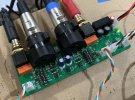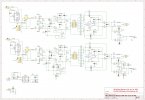Before someone starts complaining that this is not a "real" amplifier as it does not have enough power at 50w into 8 ohms and 80w into 4 ohms, I'd just like to point out a few things:
- For almost any office or other near/mid field listening, this is plenty of power even for inefficient speakers.
- If used with speakers with high but not extreme sensitivity of 89 dB SPL / 1W@1m, it will be the equivalent of a 200/320 watt amp when used with low sensitivity speakers of 83 dB SPL / 1W@1m.
- Similarly, if used at a listening distance of 6', this will be the equivalent of a 200/320 watt amp when used at a distance of 12' to the speakers. Living rooms in many parts of the world are a lot smaller than those in America. This will be fine in them.
- Even in a typically sized living room for someone in America who would be likely to consider an amp in this price range, this will be plenty of power for average sensitivity stand mount speakers being used with a subwoofer.
- It has a decent amount of reserve power for peaks, similar to class AB amps, and it has no problem controlling the moderately difficult to drive Infinity R153s.
If you need a phono input or multiple RCA inputs, this probably is not the amp for you unless you are willing to use a preamp.
While it is totally unnecessary for desktop use, with such low noise and low distortion even at low power, I can't help wishing this came with a remote. However, that might push the cost up another $25-$50.
Yes, this would be great for the JBL Stage A130, in my opinion, although I personally might be inclined to go with a somewhat less expensive amp and somewhat better speakers (Wharfedale Diamond 12.1, maybe?) for the same price.
That is my favorite feature, appearance-wise!


